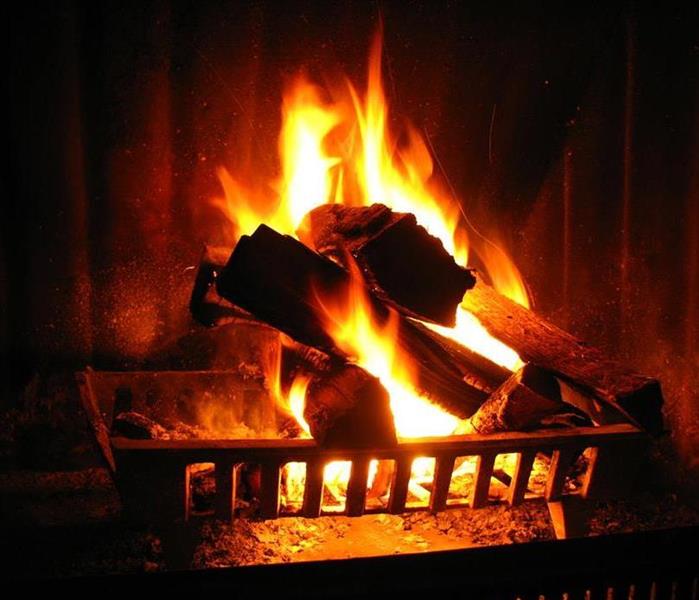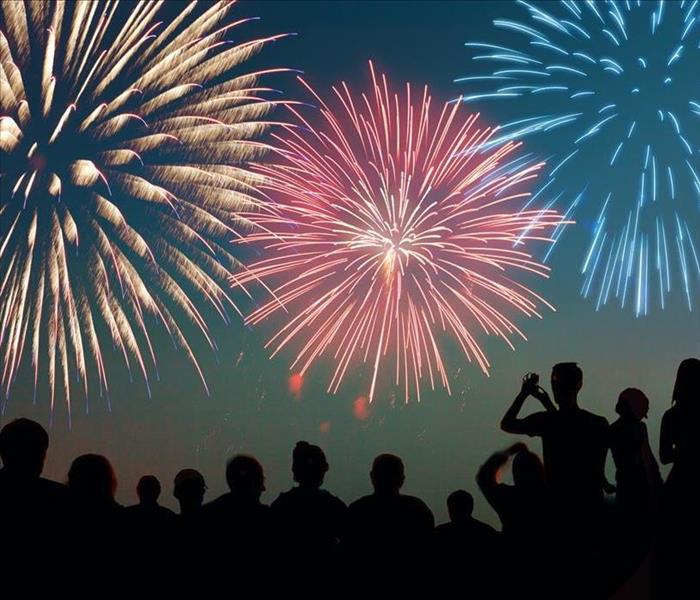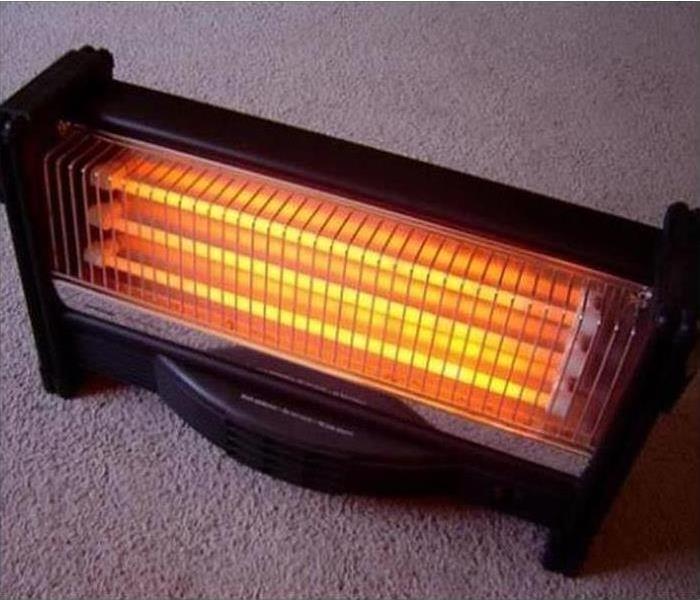Archived Fire Damage Blog Posts
Christmas Tree Fire Safety 101
12/7/2022 (Permalink)
 Having proper fire safety knowledge can put your mind at ease and let you enjoy the holidays with a wonderfully decorated tree!
Having proper fire safety knowledge can put your mind at ease and let you enjoy the holidays with a wonderfully decorated tree!
It's December, and around this time of year, many families will be getting a tree to decorate for the holiday season. While artificial trees are very popular to use for ease of setup and cleanup, many families opt to use real evergreen trees for decorating. There's certainly a special feeling about going out with the family to get the right tree!
Living trees inside a home can raise risks of a fire hazard, so we at SERVPRO® are Here to Help™ with some handy tips for how you can keep your home and office safe for the holidays.
- Make sure the lights you purchase for your tree are safe for use in it. Some lights have a higher wattage and produce more heat than others. Making sure you choose the right kind of lights can make all the difference in preventing a fire.
- Make sure your live tree gets plenty of fresh water. When purchasing a tree, also look out for ones that are incredibly dry or are shedding needles. These are more susceptible to fire damage.
- Always unplug your lights when you go to sleep or leave the home/office. Accidents can happen when you least expect them to, so make sure the lights are off and unplugged whenever you're not home to keep a close eye on your tree.
- Make sure your tree is at least 3 feet away from any source of heat. The hotter and dryer the tree gets, the more likely that it could catch fire in the event of faulty wiring in the lights or if there is a live flame near it. Keeping it away from heat sources serves to mitigate this issue.
With these handy fire safety tips in mind, you'll be able to go all out in decorating your tree for the holidays. In the event of fire and smoke damage, you can also call us here at SERVPRO of Kaufman County, Mesquite to assist and make the damage "Like it never even happened™".
Dryer Fires: How To Avoid Them
7/25/2022 (Permalink)
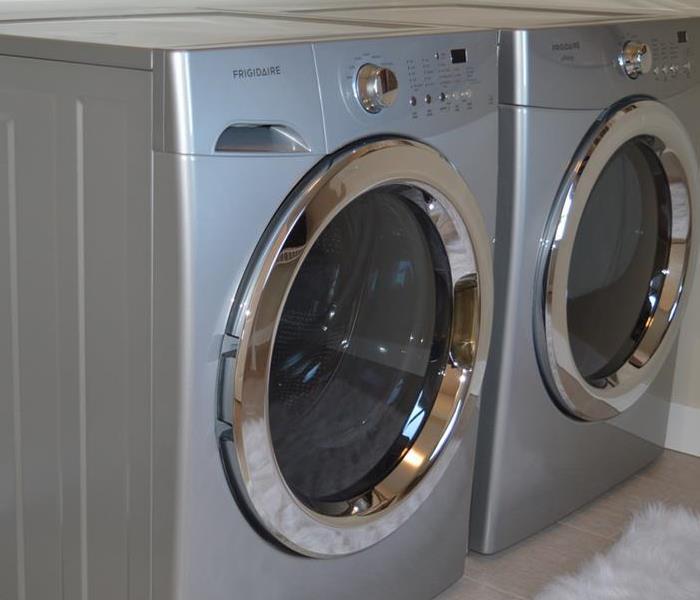 Keeping a dryer's ducts and lint filter free of debris is a great way to avoid a dryer fire.
Keeping a dryer's ducts and lint filter free of debris is a great way to avoid a dryer fire.
Laundry is one of those inevitable parts of life, painstaking in its process and unavoidable. If you have a large family, the domestic chores can become overwhelming at time and dryer safety is a critical concern that most people overlook in the bustle of day-to-day life. At SERVPRO of Kaufman County / Mesquite, we've seen first hand the devastation dryer fire can cause. Anyone with access to the machine must be aware of the risk factors for dryer fires, as well as what can be done to prevent them. Every year sadly, dryers cause catastrophic damage and loss to American families.
The following is what the US Fire Administration says regarding dryer fires:
- Every year, 2,900 dryer fires occur.
- Property damage from these dryer fires is estimated to be in over 35 million dollars.
- These fires also result in 100 injuries and 5 deaths each year.
How can dryers be dangerous?
- The lint filter keeps lint and debris out of the dryer's internal mechanics, preventing them from becoming caught and causing a fire. Using a dryer without the filter in place is one way an innocuous household appliance can become a serious hazard.
- Similarly, overloading your dryer can result in lint buildup, which can cause fire.
- It's a risk to leave your dryer on while you sleep or leave the house. If a lint buildup or another issue causes a fire, you may not be able to put it out or even be aware of the condition until it is too late.
How can homeowners protect against dryer fire?
- According to the United States Fire Administration, overfilled lint traps cause 34% of dryer fires each year. Cleaning your lint filter ensures that your dryer is properly ventilated. Dryer ventilation allows garments to dry faster while also preventing the overheating that can cause fire.
- It is critical to inspect dryer ductwork on a regular basis. Blocked ducts can also cause overheating which leads to fires. One symptom of a blocked duct is if your clothing takes longer to dry than expected. If you notice any obstructions in the ducts, clear them out before using the dryer again.
- Replace any ducts that are outdated or damaged beyond repair. For new ducts, heavy-duty metal is indicated as the best material to use.
Regardless of how many safeguards are taken, homeowners may still face dryer fires. If the worst happens, your friends at SERVPRO of Kaufman County / Mesquite are ready to step in. Restoring your home is our business, and our expert technicians are on hand and ready to limit the spread of damage and restore your home quickly, and safely. We hope you are never affected by dryer, or any kind of fire. But if you are, SERVPRO of Kaufman County / Mesquite is always here to help.
Smoke Alarms and How They Help
7/14/2022 (Permalink)
 Making sure your smoke alarm is in good condition can be all the difference in keeping your home or business safe.
Making sure your smoke alarm is in good condition can be all the difference in keeping your home or business safe.
Checking smoke alarms on a regular basis is an important element of home and building maintenance that will keep your house or company safe. Smoke detector checks are a simple and effective way to safeguard your building and its occupants from smoke and fire emergencies, and keeping yours in good working order doesn't take much effort. Make sure your smoke detectors are working properly by following the guidelines below.
Why check smoke alarms?
Smoke alarms are one of the few products in your house or business that can genuinely save lives in the event of a fire. According to the National Fire Prevention Association, house fires are more than twice as likely to turn deadly in homes without functional smoke detectors. Whether it's a large commercial facility that takes additional time to evacuate or family home full of individuals who are sleeping, providing as much time as possible to flee the premises is critical during a fire. Working smoke alarms provide important early notice which can directly affect the survival of valued family and employees.
Tips for checking smoke detectors
While smoke detector technology has improved and become more dependable than ever before, it is still necessary to inspect and test yours on a regular basis. To conduct a complete smoke detector check in your home or office, follow these suggestions from the experts at SERVPRO Kaufman County, Mesquite. Enjoy daily peace of mind knowing that you'll have life-saving assistance when you need it most.
- Be compliant: The National Fire Protection Association (NFPA) maintains fire prevention rules and requirements for all types of occupancies. To guarantee you have the most up-to-date information and are in compliance, look into the National Fire Alarm and Signaling Code and the Life Safety Code from the National Fire Protection Association (NFPA).
- Adhere to manufacturer guidelines: The maker of your smoke detectors will provide model-specific maintenance and testing recommendations for your home or company. All documentation should be kept so that you can refer to it as needed.
- Check to see what types of smoke detectors are installed: Smoke detectors are divided into two types that are typically seen in homes and workplaces. A smoke alarm that runs on batteries is common in homes and may be fitted almost anyplace. An AC-powered (hard-wired) smoke detector is better suited for long-term use and is commonly found in commercial buildings.
- Alert your family/employees and run tests. Smoke detectors emit a high-pitched sound that may offend or frighten some members of your family, staff, or customers. Everyone will be able to shield their ears or prepare for the sound if they are given advance notice prior to smoke alarm testing.
- Assign someone to stand at the furthest location from the alarm: While the sound of a smoke alarm test may be audible close to the device, it may not be audible elsewhere on your property. Consider installing another smoke alarm in that area if the sound is low or muffled.
- Monthly testing: Use the integrated test button to check every smoke alarm in the building at least once a month. To indicate that the device is receiving electricity, some newer models have flashing or steady LEDs that shine. Other models are linked, allowing you to test them all at the same time.
- Replace the batteries in your smoke detectors at least once a year if they have a replaceable battery. Do not wait until your alarms begin to chirp before replacing the batteries. Make a note of it and make sure you're always safe. When you adjust your clocks for daylight savings time, it's a good idea to replenish your batteries.
- Replace smoke detectors every ten years or 87,000 hours to guarantee you have the most up-to-date technology and the finest protection possible. Even "long-life" smoke alarms must be changed after 10 years since non-removable lithium batteries only have a 10-year guarantee. This is necessary owing to a buildup of impurities in the internal sensors.
Protect your home or business by maintaining your smoke detectors.
Any home or business can be destroyed by a fire. While SERVPRO's remediation experts are here to help you recover from smoke or fire damage to your home or company, you can make sure the right safety procedures and equipment are in place to keep your family and coworkers safe and minimize fire damage in an emergency.
The Do's and Don'ts of Fire Damage
6/23/2022 (Permalink)
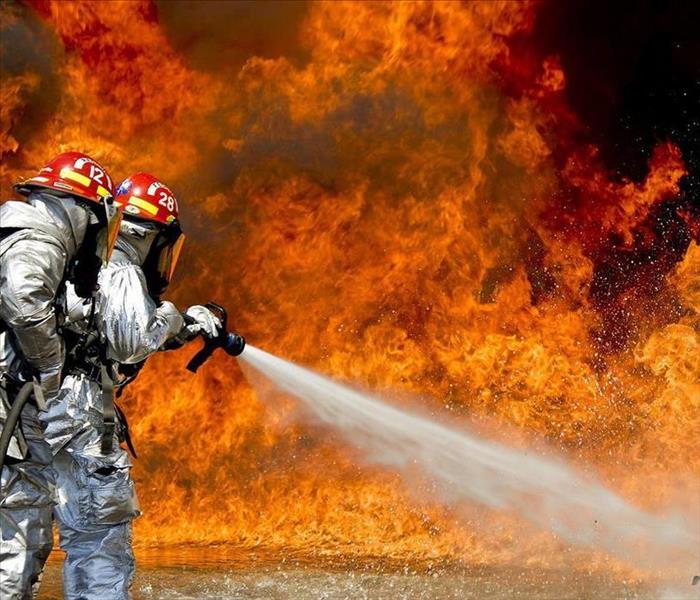 Fires are incredibly dangerous; NEVER take one on by yourself. That's best left to professionals.
Fires are incredibly dangerous; NEVER take one on by yourself. That's best left to professionals.
Dealing with the aftermath of a fire at home or your business can be overwhelming. Fire is a dangerous and complex issue, and much of the damage it leaves behind requires professional attention to ensure the safety and soundness of your home or business going forward.
Beginning clean up and restoration as soon as possible, in a smart and efficient manner, can help get your home or business up and running again quickly. Yet, if you've been the victim of fire damage, it can be difficult to know where to start or what to do, or not do.
The Do's of Fire Damage:
Prioritize safety. A visual inspection is not enough to determine the structural soundness or safety of a building exposed to fire. Regardless of your own opinion, refrain from re-entering the building until it has been cleared by a professional. As well as structural damage, some fires can also appear to be extinguished and restart later, posing a massive safety risk.
Once you are cleared to be inside the building, limit movement to prevent the spread of soot, cover dry furnishings with upholstery sheets to protect them, open windows (if weather permits) to allow ventilation, remove clothing to be cleaned by fire damage restoration cleaners, and throw away any perishables and consumables that were inside during the fire.
Document wisely. Take photographs of all damage, as soon as it is safe to do so. Record conversations, keep correspondence, file receipts and stay organized. Devote a folder in your filing cabinet or cloud service to keeping meticulous records of all things fire related - this will help immensely when dealing with your insurance company to repair the damage.
Call your insurance company as soon as you can, then call SERVPRO Kaufman County, Mesquite, and let our trained experts handle the restoration, and show you why our company motto is "Like it never even happened."
The Don'ts of Fire Damage:
Don't enter before a profession declares the building safe - worth repeating as this can literally be a life-or-death decision.
Don't start to clean up or wipe down. Everything needs to be assessed by the insurance company and you need to be given explicit go ahead before attempting any kind of clean up, even simply wiping soot from the walls.
Don't use items involved in the fire, unless appropriate. All food and drinks inside at the time of fire need to be discarded. Furniture and carpets, etc., should not be used until after they have been cleaned by a fire restoration professional. Electronic equipment also needs to be cleaned and cleared for use by professionals before being turned back on.
Don't turn on the gas, electric or water, until cleared to do so.
Dealing with the aftermath of fire is serious business. Fire and smoke damage is best dealt with by professionals who understand and are trained to provide a high quality clean up.
Call SERVPRO Kaufman County, Mesquite as soon as possible. One of our fire specialists will arrive onsite to assess your property, quickly and professionally. Our team will provide you with a clean-up and restoration plan, as well as securing the building against further damage. By enlisting the experts, you have peace of mind that restoration will be handled to a high standard of safety, workmanship, and service, in a prompt and professional manner.
Managing The Heat
6/6/2022 (Permalink)
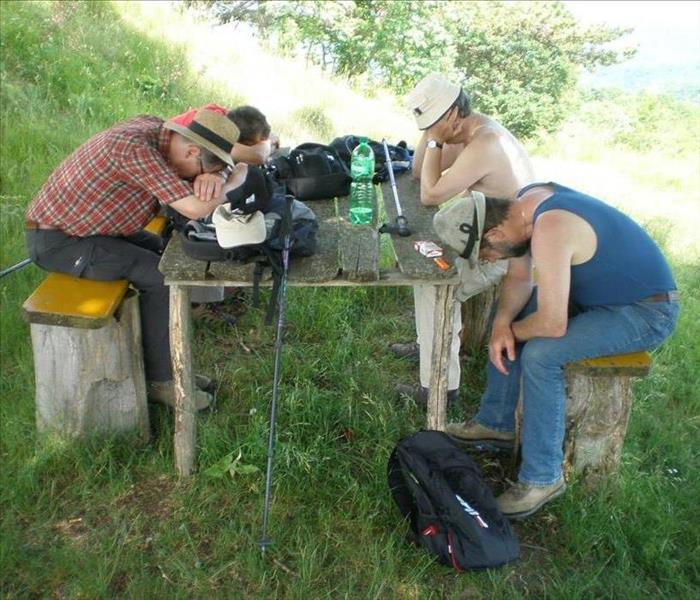 Drinking plenty of cold water is key in helping to prevent the onset of heat exhaustion!
Drinking plenty of cold water is key in helping to prevent the onset of heat exhaustion!
As we approach Summer, things are definitely going to start heating up. Just later this week, we're supposed to hit 100° F, and with heat like that, there's a chance that it could lead to heat exhaustion. Heat exhaustion (also known as heat stroke) is the most serious of heat-related illnesses, and it's important to know the warning signs and how to prevent or treat it.
WHAT ARE THE WARNING SIGNS OF HEAT EXHAUSTION?
Heat exhaustion can be predicted in advance with some knowledge of the signs. These include:
- Headache
- Dizziness or confusion
- Fast breathing or pulse
- A loss of appetite or a nauseous feeling
- Extreme thirst
- A high body temperature
HOW CAN YOU PREVENT HEAT EXHAUSTION?
- Drink plenty of cold water, especially when exercising.
- Wear light-colored and loose clothing.
- Take cool showers.
- Sprinkle water onto your skin or clothes.
- Avoid extreme exercising.
- Avoid the sun between 11AM and 3PM, when it's highest in the sky.
HOW TO TREAT HEAT EXHAUSTION?
If someone has heat exhaustion, here are a few steps you can take to cool them down and help to mitigate or remove any potential damage:
- Move them to a cool place, such as a shaded area or a building with A/C.
- Get them to lie down with elevated feet.
- Get them a cold beverage. Water and rehydration drinks with electrolytes are best for this.
- Cool their skin down with water or ice packs. High body temperature is a symptom of heat exhaustion.
With these tips in mind, you'll be ready to conquer the Texas summer in style. Always remember to practice self-care to prevent accidents like this, because at the end of the day, you matter not just to your friends and family, but also to yourself.
Smoke Alarm Upkeep
4/13/2022 (Permalink)
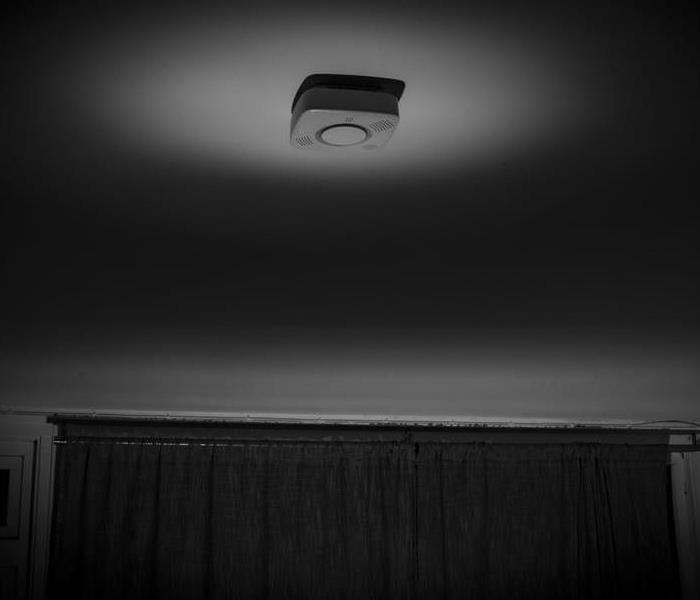 Having a working smoke alarm can be a huge boost to fire safety in the home or business!
Having a working smoke alarm can be a huge boost to fire safety in the home or business!
Smoke alarms play a vital role in saving lives, and when properly installed, can reduce the risk of fire injury in half.
The National Fire Protection Association recommends smoke alarms be installed in every bedroom, outside all sleeping quarters and on every level of the house. Business owners should consult the local Fire Marshall to ensure specific building fire codes and smoke detector requirements are met.
Smoke alarms work best when paired with a fire escape plan. A plan allows your family, employees or clients to escape quickly and safely in an emergency situation.
Review the following tips regarding smoke detectors installation and maintenance. For more on emergency preparedness contact SERVPRO of Kaufman County/Mesquite.
- Install smoke alarms on every level of the home, including the basement.
- Smoke alarms should be installed away from the kitchen to prevent false alarms. Generally, they should be at least 10 feet from a cooking appliance.
- Test smoke alarms at least once a month using the test button.
- Replace batteries in all smoke alarms at least once a year. If an alarm "chirps," the battery is low and should be replaced right away.
- Replace all smoke alarms when they are 10 years old.
The Importance of Fire Safety
2/21/2022 (Permalink)
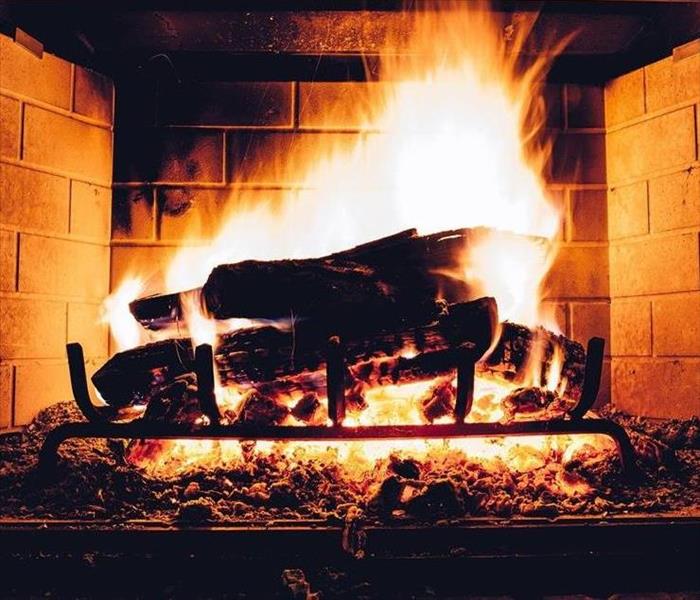 Make sure to keep fire safety in mind when heating your home or business!
Make sure to keep fire safety in mind when heating your home or business!
It seems we're not done yet with the Winter weather. Later this week, another country-wide cold snap is expected to bring deep freezing temperatures. In an effort to keep our homes and workplaces cozy, many people use alternative heat sources like fire places, portable space heaters, and wood burning stoves. Did you know, heating equipment is a leading cause of home fire deaths? According to the National Fire Protection Association, heating equipment fires cause estimated $1 billion in direct property damage annually. Keep the following safety tips in mind to help reduce your risk of a heating-related fire.
- Keep anything flammable at least three feet away from heating equipment, like the furnace, fireplace, wood stove, or a portable space heater.
- Have a three foot "kid-free zone" around open fires and space heaters.
- Make sure the fireplace has a sturdy screen to stop sparks from flying into the room. Ashes should be cool before putting them in a metal container.
- Remember to turn portable heaters off when leaving the room or going to bed.
- Always use the right kind of fuel, specified by the manufacturer, for fuel burning space heaters.
30% of all reported fires are residential home fires, and a majority of those are reported in the months of December, January, and February.
- Have heating equipment and chimneys cleaned and inspected every year by a qualified professional.
- Have a qualified professional install stationary space heating equipment, water heaters or central heating equipment according to the local codes and manufacturers instructions.
- Make sure to test smoke alarms monthly.
If your property suffers from fire damage, don't hesitate to contact SERVPRO of Kaufman County/Cedar Creek. We'll be there to make it "Like it never even happened."
Avoid Dryer Fires
7/20/2021 (Permalink)
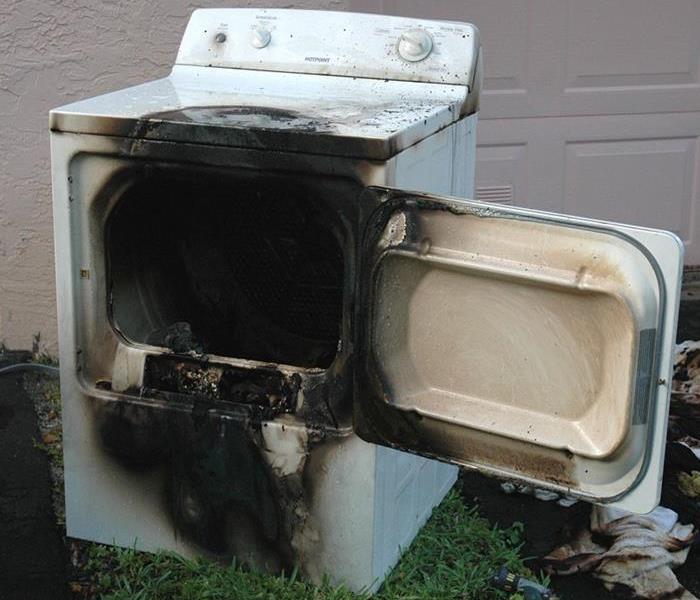 Hopefully the warranty is still in date.
Hopefully the warranty is still in date.
Laundry is one of those inevitable parts of life, painstaking in its process and unavoidable. If you have a large family, the domestic chores can become overwhelming at time and dryer safety is a critical concern that most people overlook in the bustle of day-to-day life. At SERVPRO of Kaufman County & Cedar Creek, we've seen first hand the devastation dryer fire can cause. Anyone with access to the machine must be aware of the risk factors for dryer fires, as well as what can be done to prevent them. Every year sadly, dryers cause catastrophic damage and loss to American families.
The following is what the US Fire Administration says regarding dryer fires:
- Every year, 2,900 dryer fires occur.
- Property damage from these dryer fires is estimated to be in over 35 million dollars.
- These fires also result in 100 injuries and 5 deaths each year.
How can dryers be dangerous?
- The lint filter keeps lint and debris out of the dryer's internal mechanics, preventing them from becoming caught and causing a fire. Using a dryer without the filter in place is one way an innocuous household appliance can become a serious hazard.
- Similarly, overloading your dryer can result in lint buildup, which can cause fire.
- It's a risk to leave your dryer on while you sleep or leave the house. If a lint buildup or another issue causes a fire, you may not be able to put it out or even be aware of the condition until it is too late.
How can homeowners protect against dryer fire?
- According to the United States Fire Administration, overfilled lint traps cause 34% of dryer fires each year. Cleaning your lint filter ensures that your dryer is properly ventilated. Dryer ventilation allows garments to dry faster while also preventing the overheating that can cause fire.
- It is critical to inspect dryer ductwork on a regular basis. Blocked ducts can also cause overheating which leads to fires. One symptom of a blocked duct is if your clothing takes longer to dry than expected. If you notice any obstructions in the ducts, clear them out before using the dryer again.
- Replace any ducts that are outdated or damaged beyond repair. For new ducts, heavy-duty metal is indicated as the best material to use.
Regardless of how many safeguards are taken, homeowners may still face dryer fires. If the worst happens, your friends at SERVPRO of Kaufman County & Cedar Creek are ready to step in. Restoring your home is our business, and our expert technicians are on hand and ready to limit the spread of damage and restore your home quickly, and safely. We hope you are never affected by dryer, or any kind of fire. But if you are, SERVPRO of Kaufman County & Cedar Creek is always here to help.
Four Mistakes to Avoid After Fire Damage
7/15/2021 (Permalink)
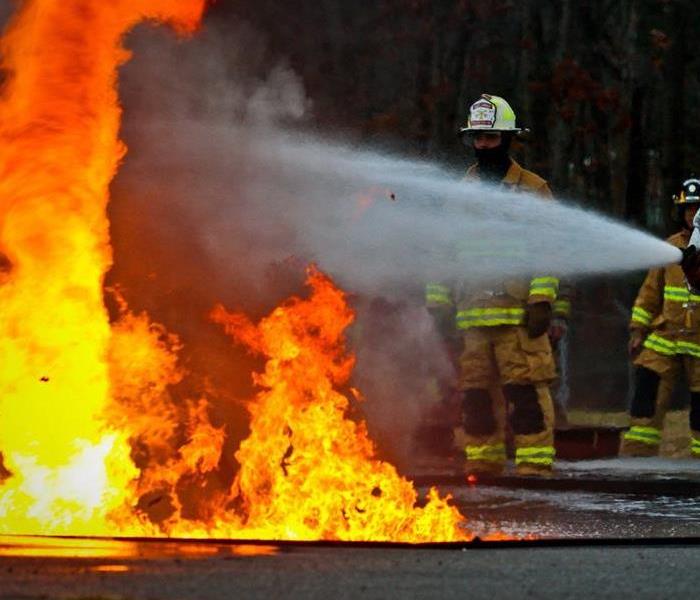 The fire is scary, but the aftermath is scarier.
The fire is scary, but the aftermath is scarier.
The aftermath of a fire may be terrible, and the prospect of repairing the damage can be daunting. Worse, the impacts of fire damage might last for a long time after the fire has been put out. SERVPRO of Kaufman County & Cedar Creek is passionate about assisting homeowners and business owners during this trying time. Our experts compiled this advice to assist our valued customers and community in avoiding the most typical mistakes made during fire damage restoration.
Take a look at the list below and make sure you don't make these mistakes, if your home or business is ever affected by fire.
Failure to secure the property in order to prevent further harm.
After a fire, properties are frequently compromised, leaving them exposed and vulnerable to further damage. Avoid this issue by contacting a fire restoration firm as soon as possible to safeguard the property against further damage.
Roofs that have been damaged should be tarped, and broken windows and doors should be boarded and secured to keep the property safe from the elements. Unauthorized entry, such as thieves or looters, can also prevented by securing the property perimeter.
Making repairs and cleaning the property before alerting the insurance company.
Before restoration can begin, the insurance company will need to view the entire amount of the damage. Before an insurance adjuster has been on site and performed a thorough assessment, don't remove anything from the property, do any cleaning or make any repairs. Leave everything precisely as it is so that all damage can be properly accounted for and an accurate loss assessment can be made by the insurance company.
Spending too much time inside the affected property before completing necessary repairs and cleaning.
Fire damage isn't just caused by active flames. Other problems that a fire can leave behind include hidden structural damage and serious health effects.
Unseen or growing deterioration to roofs and walls might cause them to collapse at any time. These dangers not only raise the likelihood of more damage and an increased cost of repairs, but they also put anyone who accesses the property in danger. Smoke inhalation, soot residue, and other toxic particles left behind by a fire pose additional health effects and concerns.
The best course of action is to avoid entering the property as much as possible until expert fire damage restoration can begin. Professional organizations like SERVPRO provide water cleanup, mold removal, soot and smoke damage cleanup, and other services in addition to significant repairs, to return the property to a safe condition.
Not immediately contacting a competent fire damage restoration business.
Specialized equipment and expertise are required for proper fire damage rehabilitation. Hiring a professional fire damage restoration company like SERVPRO right away can help homeowners avoid all of the above pitfalls, and more.
The correct fire damage restoration company will work with homeowners from start to end, assisting them in recovering as quickly as possible following fire damage. SERVPRO of Kaufman County & Cedar Creek is dedicated to providing the highest quality fire damage restoration services to our clients.
Smoke Detectors: Protect Your Home or Business from Fire
7/1/2021 (Permalink)
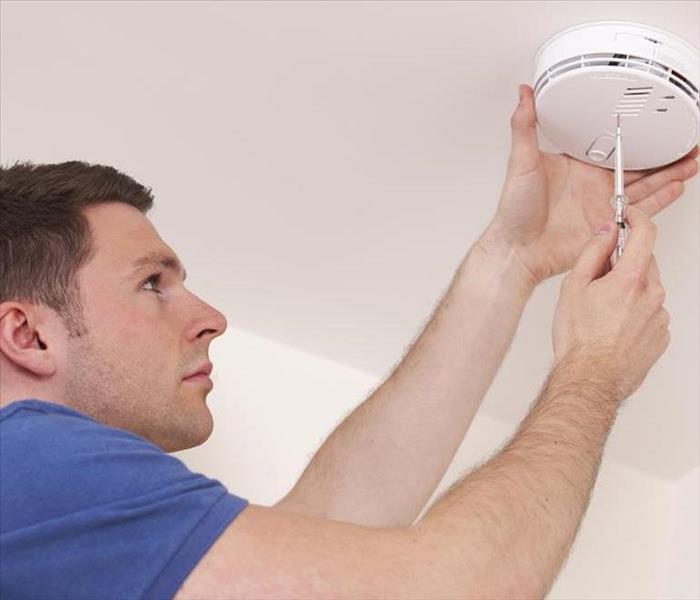 Changing your smoke detector's batteries is easy, and guarantees smoke and fires don't go unnoticed.
Changing your smoke detector's batteries is easy, and guarantees smoke and fires don't go unnoticed.
Checking smoke alarms on a regular basis is an important element of home and building maintenance that will keep your house or company safe. Smoke detector checks are a simple and effective way to safeguard your building and its occupants from smoke and fire emergencies, and keeping yours in good working order doesn't take much effort. Make sure your smoke detectors are working properly by following the guidelines below.
Why check smoke alarms?
Smoke alarms are one of the few products in your house or business that can genuinely save lives in the event of a fire. According to the National Fire Prevention Association, house fires are more than twice as likely to turn deadly in homes without functional smoke detectors. Whether it's a large commercial facility that takes additional time to evacuate or family home full of individuals who are sleeping, providing as much time as possible to flee the premises is critical during a fire. Working smoke alarms provide important early notice which can directly affect the survival of valued family and employees.
Tips for checking smoke detectors
While smoke detector technology has improved and become more dependable than ever before, it is still necessary to inspect and test yours on a regular basis. To conduct a complete smoke detector check in your home or office, follow these suggestions from the experts at SERVPRO Kaufman County & Cedar Creek. Enjoy daily peace of mind knowing that you'll have life-saving assistance when you need it most.
- Be compliant: The National Fire Protection Association (NFPA) maintains fire prevention rules and requirements for all types of occupancies. To guarantee you have the most up-to-date information and are in compliance, look into the National Fire Alarm and Signaling Code and the Life Safety Code from the National Fire Protection Association (NFPA).
- Adhere to manufacturer guidelines: The maker of your smoke detectors will provide model-specific maintenance and testing recommendations for your home or company. All documentation should be kept so that you can refer to it as needed.
- Check to see what types of smoke detectors are installed: Smoke detectors are divided into two types that are typically seen in homes and workplaces. A smoke alarm that runs on batteries is common in homes and may be fitted almost anyplace. An AC-powered (hard-wired) smoke detector is better suited for long-term use and is commonly found in commercial buildings.
- Alert your family/employees and run tests. Smoke detectors emit a high-pitched sound that may offend or frighten some members of your family, staff, or customers. Everyone will be able to shield their ears or prepare for the sound if they are given advance notice prior to smoke alarm testing.
- Assign someone to stand at the furthest location from the alarm: While the sound of a smoke alarm test may be audible close to the device, it may not be audible elsewhere on your property. Consider installing another smoke alarm in that area if the sound is low or muffled.
- Monthly testing: Use the integrated test button to check every smoke alarm in the building at least once a month. To indicate that the device is receiving electricity, some newer models have flashing or steady LEDs that shine. Other models are linked, allowing you to test them all at the same time.
- Replace the batteries in your smoke detectors at least once a year if they have a replaceable battery. Do not wait until your alarms begin to chirp before replacing the batteries. Make a note of it and make sure you're always safe. When you adjust your clocks for daylight savings time, it's a good idea to replenish your batteries.
- Replace smoke detectors every ten years or 87,000 hours to guarantee you have the most up-to-date technology and the finest protection possible. Even "long-life" smoke alarms must be changed after 10 years since non-removable lithium batteries only have a 10-year guarantee. This is necessary owing to a buildup of impurities in the internal sensors.
Protect your home or business by maintaining your smoke detectors.
Any home or business can be destroyed by a fire. While SERVPRO's remediation experts are here to help you recover from smoke or fire damage to your home or company, you can make sure the right safety procedures and equipment are in place to keep your family and coworkers safe and minimize fire damage in an emergency.
Four Most Common Types of Residential Fires.
6/29/2021 (Permalink)
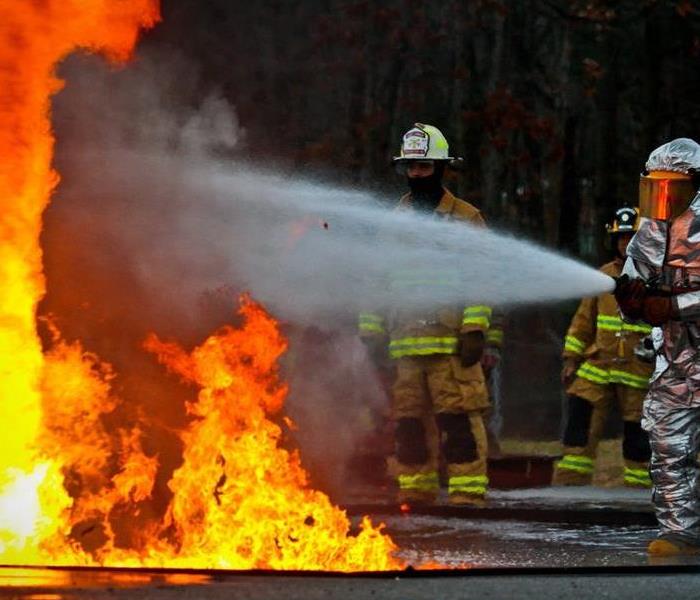 No job is too big.
No job is too big.
Being prepared for a fire is nearly impossible. They start quickly— sometimes spontaneously— and spread even faster in our furnished businesses or homes, making it difficult to stave the flames back even if you’re present for the incident. Often, home or business owners aren’t actually at the scene of the disaster and the fire is left unchecked, consuming everything in its wake before first responders can arrive.
Being prepared for a fire is nearly impossible, but being prepared for the aftermath isn’t. The key to getting your home or business back on its feet and functioning normally again is hiring the right group of professionals to mitigate the damage, reconstruct, and patch your home— and life— back together again.
SERVPRO Kaufman County & Cedar Creek is just such a group of professionals. We understand the ins and outs of fire damage with more than 50 years of industry experience under our belts. And with that experience also comes a plethora of knowledge, such as, the most common types of house fires:
- Natural fire: Greenery, such as trees and shrubs, have burned and smoke and odor have now penetrated and damaged your walls from the outside.
- Complex fire: Natural or synthetic items have burned inside your home, causing yellowish, greasy residue on contents. This usually comes paired with synthetic smoke odors. Emergency corrosion mitigation is needed to protect at-risk surfaces and materials.
- Protein fire: The oven or stove has burned contents, usually causing burnt-food and smoke odors to go unchecked inside your home, along with the smoke damage to surfaces.
- Heating malfunctions: Appliances have malfunctioned and caused smoke to be distributed throughout the home.
SERVPRO professionals, with the help of first responders and your insurance company, can help you identify which fire your home has suffered and respond accordingly, faster than the competition.
Another thing to consider when your home or business has suffered a fire loss, is the items that were left behind. Even if they weren’t all that close to the fire, certain materials can sustain damage:
- Smoke can lead to corrosion on certain materials that continues even once the fire is out.
- Odors linger well after the fire has come and gone, sometimes rendering a space completely unlivable.
- Within minutes, smoke can cause discoloration to walls and finishes; smoke can cause etching in glass, and will tarnish metal quickly.
We know it's a lot, and that it's easier to avoid the headache. SERVPRO Kaufman County & Cedar Creek is equipped to handle your loss, and we’re happy and ready to SERV. Give us a call as soon as you think you’ve suffered at the hands of a house fire, and we’ll get it right back to, “Like it never even happened.”
How to Transition into Summer, Fire Hazard Free.
4/30/2021 (Permalink)
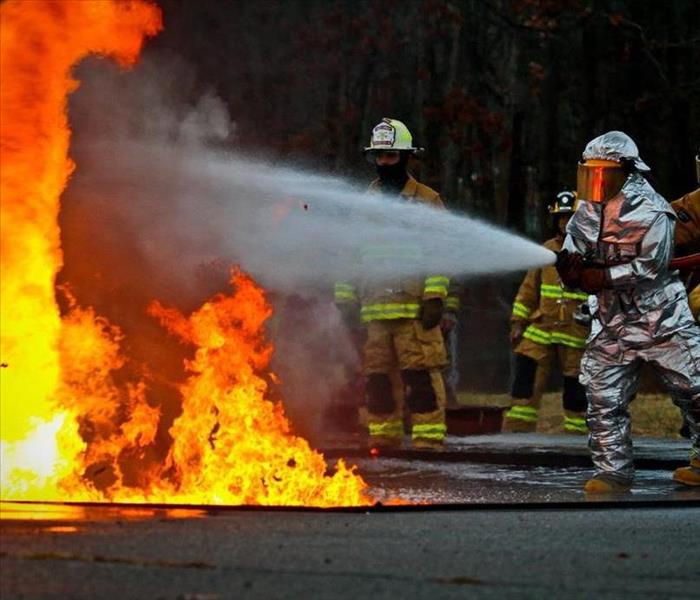 Fire damage is serious business, and seriously stressful.
Fire damage is serious business, and seriously stressful.
With Summer approaching, and the loosening of COVID restrictions, many of us are looking forward to joining with family and friends to enjoy the outdoors this summer. Camping, bonfires and cookouts are some of the most beloved American summer pastimes - they’re also some of the biggest causes of fire damage in the Summer months.
The great news is that being mindful of a few fire safety tips can easily help you avoid any disasters while you enjoy the season.
GRILL SAFETY
Any party really takes off around the grill. We all love good food and great company, but in the midst of all this, it can be easy to lost focus on safety. Make sure the person responsible for the grill, and maybe a back up helper, familiarize themselves with these grill safety tips, to make sure your cookout doesn’t end in burn out.
- Keep the grill in an open are that’s well ventilated and away from trees, shrubs, and other combustible structures like your home.
- Avoid loose fitting clothes and tie back long hair that may hang down over the open flames.
- Check all fuel connections between the gas tank and grill before starting it, if your grill runs on gas.
- If you have a charcoal grill, don’t use too much lighter fluid to start the fire and never add fluid once it’s lit.
- Ensure the grill is never unattended, and keep children and pets at a safe distance.
- Thoroughly clean the grill and utensils before and after using them.
- Never dispose of used charcoal until it has cooled completely.
BONFIRE SAFETY
Whether it’s a fire at your campsite or a bonfire under the summer stars, everyone is bound to have fun. Regardless of the type of fire, remember to practice a few safety tips to make sure your evening stays fun and safe.
- If you’re having a fire in a public setting, follow the rules and guidelines of that park or campgrounds for fires.
- Choose a safe location away from tents, trees, gazebos, and other structures that could catch fire, and be sure to build your fire in a pit to prevent unwanted spreading.
- Avoid using lighter fluid to start the fire, and do not leave it unattended.
- Plan how you will extinguish the fire before starting it. You can do this water or by shoveling dirt over the flames.
FIREWORK SAFETY
The Fourth of July is one of our favorite Summer holidays, and a great excuse to flex that firework game! Despite our love of the Holiday and the festivities, sadly thousands of Americans suffer from fire damage, both to their properties and themselves. Don’t become a statistic this summer, follow these simple firework safety tips to be the star of the show, and of safety.
- Choose fireworks that are legal. Be sure to follow all directions and warning labels when lighting them.
- Supervise all children around fireworks. The highest demographic for being injured by fireworks is boys, fourteen and under.
- Choose a safe location outside, away from your home, garage, shed, family, or grass to light the fireworks.
- If a firework fails after lighting it, dump water on it and dispose of it safely.
Your friends at SERVPRO Kaufman County & Cedar Creek want you to enjoy your summer, and we hope you never need us for fire restoration. Our experts have provided this advice, and also recommend staying in compliance with your local codes, ordinances and burn bans, to protect yourself and your property from fire damage.
If the worst happens, our professionals are ready 24/7 to assist you quickly, and to the highest standard, when it matters most.
Fire and smoke damage is a serious business, and also seriously stressful. Our expert technicians are trained to deal with damage efficiently and correctly to prevent the spread, remove smoke odor, preserve structural integrity and restore your home or building to safety.
If you’re affected by Fire Damage this summer, SERVPRO Kaufman County & Cedar Creek is ready to help.
Fire Damage: What You Need to Know
1/18/2021 (Permalink)
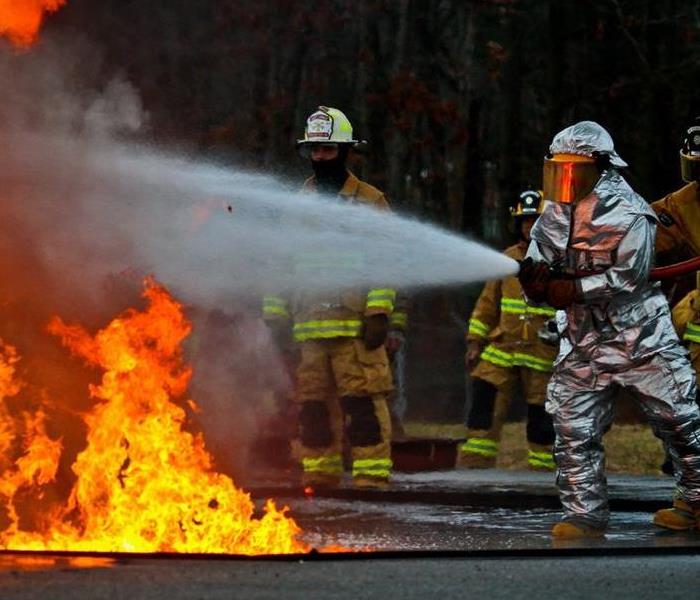 Fire damage is costly, and the fire itself is dangerous. Do not attempt to handle it without professional help.
Fire damage is costly, and the fire itself is dangerous. Do not attempt to handle it without professional help.
Dealing with the aftermath of a fire at home or your business can be overwhelming. Fire is a dangerous and complex issue, and much of the damage it leaves behind requires professional attention to ensure the safety and soundness of your home or business going forward.
Beginning clean up and restoration as soon as possible, in a smart and efficient manner, can help get your home or business up and running again quickly. Yet, if you've been the victim of fire damage, it can be difficult to know where to start or what to do, or not do.
The Do's of Fire Damage:
Prioritize safety. A visual inspection is not enough to determine the structural soundness or safety of a building exposed to fire. Regardless of your own opinion, refrain from re-entering the building until it has been cleared by a professional. As well as structural damage, some fires can also appear to be extinguished and restart later, posing a massive safety risk.
Once you are cleared to be inside the building, limit movement to prevent the spread of soot, cover dry furnishings with upholstery sheets to protect them, open windows (if weather permits) to allow ventilation, remove clothing to be cleaned by fire damage restoration cleaners, and throw away any perishables and consumables that were inside during the fire.
Document wisely. Take photographs of all damage, as soon as it is safe to do so. Record conversations, keep correspondence, file receipts and stay organized. Devote a folder in your filing cabinet or cloud service to keeping meticulous records of all things fire related - this will help immensely when dealing with your insurance company to repair the damage.
Call your insurance company as soon as you can, then call SERVPRO Kaufman County & Cedar Creek, and let our trained experts handle the restoration, and show you why our company motto is "Like it never even happened."
The Don'ts of Fire Damage:
Don't enter before a profession declares the building safe - worth repeating as this can literally be a life-or-death decision.
Don't start to clean up or wipe down. Everything needs to be assessed by the insurance company and you need to be given explicit go ahead before attempting any kind of clean up, even simply wiping soot from the walls.
Don't use items involved in the fire, unless appropriate. All food and drinks inside at the time of fire need to be discarded. Furniture and carpets, etc., should not be used until after they have been cleaned by a fire restoration professional. Electronic equipment also needs to be cleaned and cleared for use by professionals before being turned back on.
Don't turn on the gas, electric or water, until cleared to do so.
Dealing with the aftermath of fire is serious business. The residues from smoke can pose health hazards for your family and customers, and you need to move forward with confidence that your home or business is clean, safe, and functional. Fire and smoke damage is best dealt with by professionals who understand the complex chemical reactions involved, and are trained to provide a high quality clean up.
Call SERVPRO Kaufman County & Cedar Creek as soon as possible. One of our fire specialists will arrive onsite to assess your property, quickly and professionally. Our team will provide you with a clean-up and restoration plan, as well as securing the building against further damage. By enlisting the experts, you have peace of mind that restoration will be handled to a high standard of safety, workmanship, and service, in a prompt and professional manner.
Tips for Fireplace Safety
7/14/2020 (Permalink)
A poorly maintained or improperly used fireplace can be dangerous. Here’s how to enjoy your fire safely.
4 tips for fireplace safety
1. Have your fireplace cleaned and inspected regularly
According to the National Fire Protection Association, 28 percent of heating fires are caused by failing to clean equipment, especially chimneys. Over time, creosote (a sticky, flammable substance that’s released when wood’s burned) can build up in the chimney. If the creosote isn’t removed, a chimney fire can result. This is not only dangerous in itself, but it can also cause damage to the chimney, increasing the risk that flames will reach the frame of the house.
Debris such as fallen leaves and animal nests should also be removed, since they can restrict airflow and cause carbon monoxide to back up into the house. (Besides, if your chimney’s blocked, how’ll Santa get in?)
If you have a wood-burning fireplace or stove, you should have the chimney professionally inspected at least once a year (before you use it). Ask for a Level 1 inspection, which involves a visual examination of readily accessible parts of the chimney. The inspector will ensure the chimney is sturdy and perform any necessary cleaning.
Have a gas fireplace instead of a wood-burning one? You should still get a regular inspection, as corrosive deposits can build up and prevent your fireplace from venting efficiently. Debris can block this type of chimney as well.
2. Burn only dry, seasoned wood
Properly seasoned firewood contains around 20 percent water. Freshly cut wood can contain up to 45 percent water, so it takes a lot of heat to get it to catch fire (which means less heat inside your house). Burning wet wood also creates large amounts of smoke and causes creosote to build up more rapidly.
To be properly seasoned, firewood must be cut to length and allowed to dry for at least 6 months (up to a year in damp climates) before being burned. If you’ve gathered a stockpile of wood, be sure to protect it from rain and snow. If you’re buying wood to burn, look for dark edges with visible cracks. Well-seasoned firewood’s fairly lightweight and makes a clear, sharp sound when clapped together.
Resist the temptation to toss wrapping paper, cardboard boxes, or foam containers into the fireplace. Paper and cardboard can cause flames to burn too high, while foam releases toxic smoke and particles into the air.
3. Make sure your damper’s properly adjusted
The fireplace damper is a plate or valve that controls airflow in your chimney. When the fireplace isn’t in use, keep the damper closed completely to prevent heat from escaping. When lighting the fire, open the damper wide to help create a good blaze and get smoke flowing up the chimney. Once the fire’s burning well, partially close the damper to keep in warmth while still allowing smoke to escape.
4. Install and regularly check carbon monoxide detectors
Burning wood creates carbon monoxide (a poisonous gas) — but this poses little danger if your chimney’s properly maintained and free from obstructions and if your damper’s letting smoke out. Nonetheless, it’s wise to install smoke and carbon monoxide detectors close to your fireplace as well as in your bedrooms.
Now that you know how to use your fireplace safely, you can relax, toast some marshmallows, and find other way to winterize your home.
Understanding the Risk of Carbon Monoxide Poisoning
7/14/2020 (Permalink)
Each year in America, unintentional carbon monoxide poisoning claims more than 500 lives and sends another 15,200 people to the hospital emergency rooms around the country for treatment. These accidents tend to peak during the winter months, but there are several everyday items that can put you and your family at risk, too. Read on for some simple steps you can take to help protect yourself or your customers from deadly carbon monoxide fumes.
What is Carbon Monoxide?
An odorless, colorless and toxic gas, carbon monoxide cannot be seen, tasted or smelled. Since it is often impossible to detect, CO can cause harm or become fatal before you realize it is in your home. When exposed to lower levels of CO, the gas causes mild effects that are often mistaken for the flu, including headaches, dizziness, disorientation,nausea and fatigue.
It's also important to note the effects of CO exposure can vary greatly from person to person depending in age, health, and the concentration and length of exposure.
Where does it come from?
- Gas-fired appliances
- Charcoal grills
- Wood-burning furnaces or fireplaces
- automobiles
Preventative Measures
Consider installing at least one carbon monoxide alarm with an audible warning signal. The ideal placement for these alarms is near the sleeping areas of your home. Since CO alarms measure CO levels over time, the alarm will sound before an average, healthy adult would be experiencing symptoms. If you are not experiencing symptoms when the alarm sounds, please consider ventilating the home and contacting a service professional to check the CO level. If you are experiencing symptoms of CO poisoning, experts say to evacuate immediately and contact emergency personnel.
If you drive a vehicle with a tailgate or rear hatch and are travelling with he hatch open, make certain to open vents or windows to create adequate airflow. And, of course, never run your vehicle inside your garage with the door closed. Even with doors open, refrain from running your vehicle for extended periods of time, as garages with a door on only one side often do not provide adequate air flow.
Tips for Fireplace Safety
7/1/2020 (Permalink)
A poorly maintained or improperly used fireplace can be dangerous. Here’s how to enjoy your fire safely.
4 tips for fireplace safety
1. Have your fireplace cleaned and inspected regularly
According to the National Fire Protection Association, 28 percent of heating fires are caused by failing to clean equipment, especially chimneys. Over time, creosote (a sticky, flammable substance that’s released when wood’s burned) can build up in the chimney. If the creosote isn’t removed, a chimney fire can result. This is not only dangerous in itself, but it can also cause damage to the chimney, increasing the risk that flames will reach the frame of the house.
Debris such as fallen leaves and animal nests should also be removed, since they can restrict airflow and cause carbon monoxide to back up into the house. (Besides, if your chimney’s blocked, how’ll Santa get in?)
If you have a wood-burning fireplace or stove, you should have the chimney professionally inspected at least once a year (before you use it). Ask for a Level 1 inspection, which involves a visual examination of readily accessible parts of the chimney. The inspector will ensure the chimney is sturdy and perform any necessary cleaning.
Have a gas fireplace instead of a wood-burning one? You should still get a regular inspection, as corrosive deposits can build up and prevent your fireplace from venting efficiently. Debris can block this type of chimney as well.
2. Burn only dry, seasoned wood
Properly seasoned firewood contains around 20 percent water. Freshly cut wood can contain up to 45 percent water, so it takes a lot of heat to get it to catch fire (which means less heat inside your house). Burning wet wood also creates large amounts of smoke and causes creosote to build up more rapidly.
To be properly seasoned, firewood must be cut to length and allowed to dry for at least 6 months (up to a year in damp climates) before being burned. If you’ve gathered a stockpile of wood, be sure to protect it from rain and snow. If you’re buying wood to burn, look for dark edges with visible cracks. Well-seasoned firewood’s fairly lightweight and makes a clear, sharp sound when clapped together.
Resist the temptation to toss wrapping paper, cardboard boxes, or foam containers into the fireplace. Paper and cardboard can cause flames to burn too high, while foam releases toxic smoke and particles into the air.
3. Make sure your damper’s properly adjusted
The fireplace damper is a plate or valve that controls airflow in your chimney. When the fireplace isn’t in use, keep the damper closed completely to prevent heat from escaping. When lighting the fire, open the damper wide to help create a good blaze and get smoke flowing up the chimney. Once the fire’s burning well, partially close the damper to keep in warmth while still allowing smoke to escape.
4. Install and regularly check carbon monoxide detectors
Burning wood creates carbon monoxide (a poisonous gas) — but this poses little danger if your chimney’s properly maintained and free from obstructions and if your damper’s letting smoke out. Nonetheless, it’s wise to install smoke and carbon monoxide detectors close to your fireplace as well as in your bedrooms.
Now that you know how to use your fireplace safely, you can relax, toast some marshmallows, and find other way to winterize your home.
Firework Safety this Summer
6/29/2020 (Permalink)
With Summer Coming up, celebrate it safely!
Fireworks can be a festive and fun way to celebrate the holidays. In the United States, no holiday is more widely celebrated with the colorful displays of pyrotechnics than the Fourth of July.
However, each year in July, thousands of people - both children and adults - are injured by fireworks while celebrating. According to a U.S. Consumer Product Safety Commission study conducted in 2006, emergency departments treated more than 9,200 firework-related injuries from June 16 to July 16 (2006). Sparklers accounted for one0third of the injuries to children under the age of 5 in the same time period. Children under 15 accounted for 36% of estimated injuries.*
Since a large percentage of the injuries from fireworks are related to illegally made fireworks, the American Pyrotechnics Association (APA) encourages consumers to only use legal, approved fireworks. Of course, even then, the fireworks must be used as directed in a safe and responsible manner.
Though a professional fireworks display is the safest way to enjoy the aerial displays, the National Council on Fireworks Safety suggest the following tips for a fun, safe fireworks display.
SAFETY TIPS
• Only use fireworks outdoors.
• Be aware of and obey all local laws regarding the use of fireworks.
• Always have a bucket of water or hose nearby. If conditions are excessively dry, do not use fireworks.
• Alcohol and fireworks are a bad mix!
• Parents should pay special attention to children using sparklers. Sparklers can reach temperatures up to 1,800 degrees Fahrenheit. Children should not throw or play games with sparklers.
Understanding The Behavior of Smoke
5/1/2020 (Permalink)
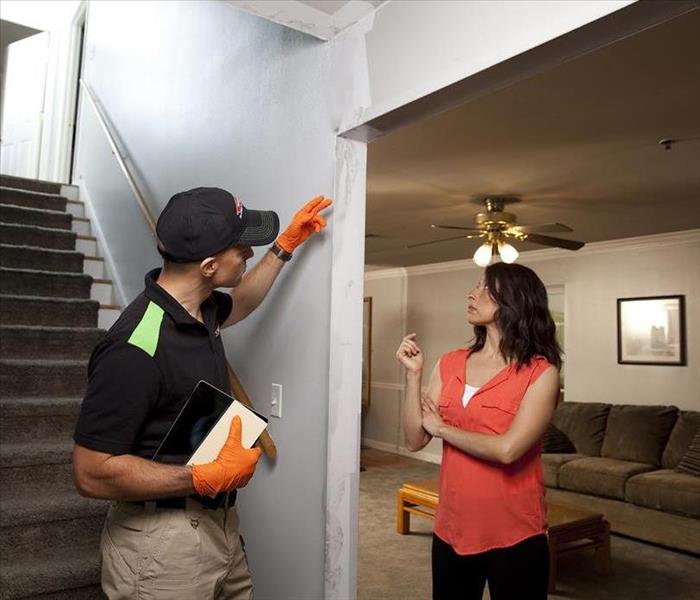 If your home or business experiences smoke or fire damage, call SERVPRO of Kaufman County/Cedar Creek for a free inspection 972-524-3894
If your home or business experiences smoke or fire damage, call SERVPRO of Kaufman County/Cedar Creek for a free inspection 972-524-3894
The damage to your property following a fire can often be complicated due to the unique behavior of smoke. There are two different types of smoke- wet and dry. As a result, there are different types of soot residue after a fire. SERVPRO of Kaufman County/Cedar Creek professionals are thoroughly trained in fire cleanup and restoration and know the different types of smoke and their behavior patterns. Knowing this information is vital to proper restoration. Before restoration begins, SERVPRO of Kaufman County/Cedar Creek professionals will survey the loss to determine the extent of impact from fire, smoke, heat, and moisture on the building materials and contents. The soot will then be tested to determine which type of smoke damage occurred. Pretesting determines the proper cleaning method and allows SERVPRO of Kaufman County/Cedar Creek to focus on saving your precious items.
SERVPRO of Kaufman County/Cedar Creek professionals know smoke can penetrate various cavities within the structure, causing hidden damage and odor. Their knowledge of building systems helps them investigate how far smoke damage may have spread. The following are additional facts you may not know about smoke.
- Hot smoke migrates to cooler areas and upper levels of a structure.
- Smoke flows around plumbing systems, seeping through the holes used by pipes to go from floor to floor.
- The type of smoke may greatly affect the restoration process.
Different Types Of Smoke
Wet Smoke- Low heat, smoldering, pungent odor, sticky, smeary. Smoke webs are more difficult to clean.
Dry Smoke (paper and wood)- Fast burning, high temperatures, heat rises therefore smoke rises.
Protein Fire Residue (produced by evaporating of materials rather than from a fire)- Virtually invisible, discolors paints and varnishes, extreme pungent odor.
Fuel Oil Soot (Furnace Puff Backs)- While "puff backs" can create havoc from homeowners, SERVPRO of Kaufman County/Cedar Creek professionals can, in most cases, restore the contents and structure quickly.
Other Types (Tear gas, fingerprint powder and fire extinguisher residue)- Special loss situations require special care.
SERVPRO of Kaufman County/Cedar Creek professionals are trained to handle even the toughest losses. If your home or business suffers from fire or smoke damage, contact SERVPRO of Kaufman County/Cedar Creek to help make it "Like it never even happened." 972-524-3894
Halt Winter Heating Hazards
1/16/2020 (Permalink)
The winter season is here and with it comes shorter days and lower temperatures. No matter where you live, winter brings a change in the weather. In an effort to keep our homes and workplaces cozy, many people use alternative heat sources like fire places, portable space heaters, and wood burning stoves. Did you know, heating equipment is a leading cause of home fire deaths? According to the National Fire Protection Association, heating equipment fires cause estimated $1 billion in direct property damage annually. Keep the following safety tips in mind to help reduce your risk of a heating-related fire.
- Keep anything flammable at least three feet away from heating equipment, like the furnace, fireplace, wood stove, or a portable space heater. Have a three foot "kid-free zone" around open fires and space heaters.
- Make sure the fireplace has a sturdy screen to stop sparks from flying into the room. Ashes should be cool before putting them in a metal container. Keep the container a safe distance away from your home.
- Remember to turn portable heaters off when leaving the room or going to bed.
- Always use the right kind of fuel, specified by the manufacturer, for fuel burning space heaters.
50% of all residential heating-related fires are reported during the months of December, January and February.
- Have heating equipment and chimneys cleaned and inspected every year by a qualified professional.
- Have a qualified professional install stationary space heating equipment, water heaters or central heating equipment according to the local codes and manufacturers instructions.
- Test smoke alarms monthly.
If your property suffers from fire damage, contact SERVPRO Of Mesquite to help make it "Like it never even happened."
Eliminate potential risks this holiday season
4/18/2019 (Permalink)
Use Only Non-Flammable Decorations
All decorations, including a metallic or artificial tree, should be flame retardant. Be sure you place all decorations away from heat vents and heating sources.
Maintain Holiday Lights
Prior to decorating, check holiday lights for frayed wires, bare spots, gaps in insulation, broken or cracked sockets and excessive wire kinking. Only use lighting listed by an approved testing laboratory. Lights should be inspected yearly.
Do Not Overload Electrical Outlets
Do not link more than three light strands together, unless directions indicate it is safe. Connect strings of lights to an extension cord before plugging the cord into the wall outlet. periodically, check the wires- they should not be warm to the touch.
Avoid Using Lit Candles
If you enjoy decorating with candles, consider choosing flame less candles. If you do use candles, make sure they are in low traffic areas, where they cannot easily be knocked down. Never leave the building with a candle burning.
Don't Block Exits
Ensure that trees and other decorations do not block an exit way. In the event of the fire, a blocked entry/exit puts you at risk.
As in every season, check all smoke and fire detectors to ensure they are in proper working order. Test the detectors monthly and keep them equipped with fresh batteries.
 Having proper fire safety knowledge can put your mind at ease and let you enjoy the holidays with a wonderfully decorated tree!
Having proper fire safety knowledge can put your mind at ease and let you enjoy the holidays with a wonderfully decorated tree!




 24/7 Emergency Service
24/7 Emergency Service












